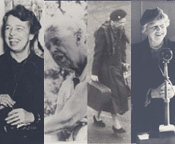
The Eleanor Roosevelt Papers Project is a university-chartered research center associated with the Department of History of The George Washington University

First Lady of the World
Click to explore the enlarged map
Eleanor Roosevelt was legendary for her ability to turn up anywhere. In just her first year as First Lady, she traveled over 40,000 miles. Over the course of her life, she visited every continent except Antarctica, and all 48 of the (then) United States. The documents in this mini-edition show a little of the insight ER gained from traveling so widely, and demonstrate the importance of her roles as both an international correspondent and an informal diplomat. The editors have chosen to launch this site with documents from four of ER's international trips:
- Touring the British Homefront (1942)
- In the South Pacific War Zone (1943)
- Postwar Europe: A Haunting Horror (1946)
- Europe II: A Magna Carta for all Mankind (1948)
- Traveling Around the World (1952)
- Promoting Democracy in Japan (1953)
- The Long Way Home (1953)
- On Soviet Soil (1957)
Some of the material included here was written while ER was traveling; other documents in this series represent her later reflections on what she saw and experienced. The editors intend to expand this site to include more of ER's travels, including trips to Central and South America, Africa, Europe, and trips within the United States itself.
As First Lady, ER spent most of her time traveling within the United States giving lectures, visiting New Deal projects, and touring schools, mines, factories and other institutions. During World War II she also traveled to the South Pacific, England, and Latin America. Two of these trips took her into war zones, and the trip through the South Pacific was deemed so dangerous that the troops often found out she was coming only when she arrived.
After FDR’s death in 1945, ER’s travels became even more extensive. As a delegate to the United Nations she journeyed regularly to Europe to attend meetings of the General Assembly and the Human Rights Commission. She wanted to go to communist China, but settled for the Soviet Union. She met with Nehru in India, interviewed Tito in Yugoslavia and Khrushchev in Yalta, chastised women for their support of Hitler in postwar Germany, and defended the atomic bomb in Hiroshima. Often her trips lasted only a day or two, but when ER really wanted to get to know a country she spent as much as a month in a single nation. Wherever ER went, she visited royal palaces and housing projects, spoke to world leaders and student groups and gave speeches, press conferences, and interviews. She always sought, however, to escape the spotlight long enough to see and speak to average citizens. The world was her neighborhood, and as a good neighbor she believed it was her responsibility to see that all people everywhere lived with dignity and hope.
Sources:
Emma Bugbee. "America's Most Traveled First Lady," in Literary Digest (28 April 1934): 9, 39; Blanche Wiesen Cook, Eleanor Roosevelt Volume 2: The Defining Years (New York: Penguin Books, 1999); Kelly, A. J. Powers, “Travels” in The Eleanor Roosevelt Encyclopedia, ed, Maurine H. Beasley, Holly C. Shulman and Henry R. Beasley, (Westport: Greenwood Press, 2001).
